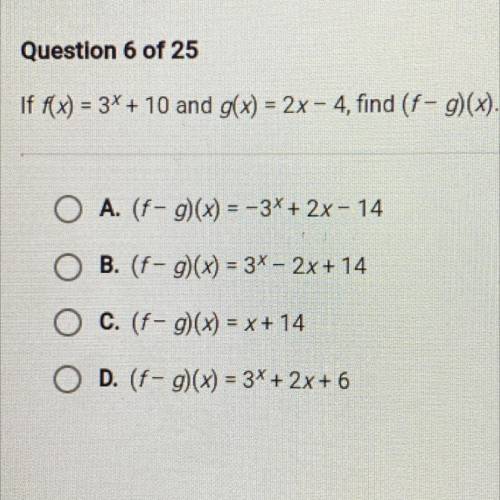O B. (f-9% = 3- 2x + 14

Mathematics, 09.06.2021 01:30 453379
If A ) = 3+ 10 and 0%) = 2%-4, find (f-9.
O A. (-96) = -34 + 2%-14
O B. (f-9% = 3- 2x + 14
O C. (f-9 = x+ 14
D. (f- g() = 3' + 2x+6


Answers: 2


Another question on Mathematics

Mathematics, 21.06.2019 19:30
You have learned about the six trigonometric functions, their definitions, how to use them, and how to represent them graphically. the sine, cosine, and tangent trigonometric functions can be paired with their reciprocal functions, cosecant, secant, and cotangent, respectively. think about how each function is related to its reciprocal function.how are the graphs of the reciprocal functions related to their corresponding original functions? what happens to the graphs of the reciprocal functions as x approaches the zeros of the original functions? describe how you would teach friends with different learning styles (visual-spatial, aural-auditory, verbal-linguistic, physical-bodily-kinesthetic, logical-mathematical, social-interpersonal, and solitary-intrapersonal) how to graph the reciprocal functions
Answers: 2

Mathematics, 21.06.2019 21:30
Noel is hoping to make a profit (in $) on the school play and has determined the function describing the profit to be f(t) = 8t – 2654, where t is the number of tickets sold. what does the number 8 tell you?
Answers: 1

Mathematics, 21.06.2019 22:30
Which statement shows that 6.24 is a rational number? a. 6.24 = 6.242424 b. 6.24 = 6.24 c. 6.24 = 68⁄33 d. 6.24 = 66⁄25
Answers: 1

Mathematics, 21.06.2019 23:00
Each of the following data sets has a mean of x = 10. (i) 8 9 10 11 12 (ii) 7 9 10 11 13 (iii) 7 8 10 12 13 (a) without doing any computations, order the data sets according to increasing value of standard deviations. (i), (iii), (ii) (ii), (i), (iii) (iii), (i), (ii) (iii), (ii), (i) (i), (ii), (iii) (ii), (iii), (i) (b) why do you expect the difference in standard deviations between data sets (i) and (ii) to be greater than the difference in standard deviations between data sets (ii) and (iii)? hint: consider how much the data in the respective sets differ from the mean. the data change between data sets (i) and (ii) increased the squared difference îł(x - x)2 by more than data sets (ii) and (iii). the data change between data sets (ii) and (iii) increased the squared difference îł(x - x)2 by more than data sets (i) and (ii). the data change between data sets (i) and (ii) decreased the squared difference îł(x - x)2 by more than data sets (ii) and (iii). none of the above
Answers: 2
You know the right answer?
If A ) = 3+ 10 and 0%) = 2%-4, find (f-9.
O A. (-96) = -34 + 2%-14
O B. (f-9% = 3- 2x + 14
O B. (f-9% = 3- 2x + 14
Questions


Mathematics, 29.07.2019 00:00

Mathematics, 29.07.2019 00:00


English, 29.07.2019 00:00

English, 29.07.2019 00:00

Mathematics, 29.07.2019 00:00




Health, 29.07.2019 00:00

Health, 29.07.2019 00:00

History, 29.07.2019 00:00


Health, 29.07.2019 00:00




Mathematics, 29.07.2019 00:00

Mathematics, 29.07.2019 00:00




